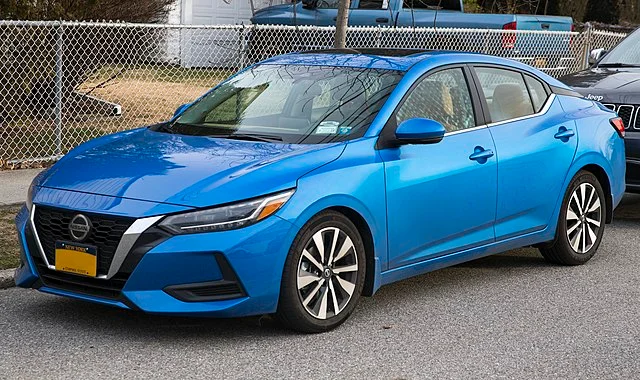Ever seen the letters ‘SV’ on the back of a car and felt a spark of curiosity? You’re not alone. This simple two-letter badge can signify wildly different things, causing confusion for car buyers and enthusiasts alike. One ‘SV’ might mean you’re looking at a smart, feature-packed family vehicle, while another could mean you’re witnessing a track-focused supercar with extreme performance. Understanding this distinction is key to knowing exactly what a car has to offer.
On a car, the acronym SV most commonly means either ‘Standard Value’ for brands like Nissan, representing a feature-rich mid-tier trim, or ‘Super Veloce’ (Italian for ‘Super Fast’) for high-performance brands like Lamborghini, signifying a model engineered for maximum speed.
This comprehensive guide, based on a deep analysis of manufacturer specifications and automotive data, will completely demystify the ‘SV’ badge. We will break down exactly what this acronym means in its two most popular contexts, compare it to other common trim levels, and answer all your follow-up questions. By the end, you’ll be able to instantly tell the difference between a car that’s a great value and one that’s just super fast.
Key Facts
- Dual Identity: The ‘SV’ acronym has two primary, and very different, meanings in the automotive world: “Standard Value” as used by Nissan, and “Super Veloce” (Super Fast) as used by Lamborghini.
- Mid-Tier Placement: For Nissan, the SV trim is not a base model. It is strategically positioned above the entry-level ‘S’ trim to offer a significant upgrade in features and comfort.
- Historical Performance: The Lamborghini ‘SV’ designation has a rich history, first appearing on the iconic Miura SV in the early 1970s, establishing a legacy of high-performance variants.
- Extreme Power: The performance meaning of SV is backed by serious numbers. As highlighted by manufacturer data, the Lamborghini Aventador SV boasts a naturally aspirated V12 engine that produces an immense 750 horsepower.
- Advanced Technology: In its “Standard Value” context, the SV trim often provides access to advanced driver-assistance features. For example, data shows the Nissan Pathfinder SV can be equipped with the ProPilot Assist® system.
The Two Meanings of SV on a Car: A Complete Guide
On a car, SV most commonly means either ‘Standard Value’ for brands like Nissan, representing a feature-rich mid-tier trim, or ‘Super Veloce’ (Italian for Super Fast) for high-performance brands like Lamborghini. The key is that the meaning is entirely dependent on the manufacturer. A “trim level” is a version of a car model that comes equipped with a specific set of features, while a “performance variant” is a version specifically engineered for higher speed and better handling.

The two interpretations could not be more different, highlighting the vast gap between everyday value and ultimate performance in the automotive world.
- Standard Value (SV): This meaning is most famously used by Nissan. It designates a mid-range trim level that provides a “standard” package of popular features, offering great “value” for the money. It’s the perfect middle ground for the average car buyer.
- Super Veloce (SV): This meaning is exclusive to the Italian supercar brand Lamborghini. Veloce is Italian for “fast,” so Super Veloce translates to “Super Fast.” This badge is reserved for special, track-focused versions of their cars that have more power, less weight, and extreme aerodynamics.
So, how do you know if the ‘SV’ on a car means a great value or extreme speed? It all comes down to the badge on the hood.
Nissan’s SV Trim: The “Standard Value” Proposition
For Nissan, SV stands for “Standard Value” and represents a mid-tier trim that adds significant features over the base ‘S’ model, providing a strong balance of amenities and price. It’s one of the most popular trim levels across the Nissan lineup because it hits the sweet spot for many buyers who want more than just the basics. For the 2025 model lineup, the SV continues to be a central part of Nissan’s product strategy.

Here’s a breakdown of what defines the Nissan SV trim:
- Mid-Tier Positioning: The SV is the logical step up from the base ‘S’ (Sport or Standard) trim. It sits comfortably below the more luxurious and feature-heavy ‘SL’ (Sport Luxury or Special Luxury) trim.
- Enhanced Features: This is where the “value” comes in. An SV model typically adds crucial upgrades. For example, a Nissan Sentra SV might include Intelligent Cruise Control, a more advanced infotainment system with a larger screen, and stylish aluminum-alloy wheels. A larger vehicle like the Nissan Pathfinder SV often gets features like the ProPilot Assist® driver aid, heated front seats, and a convenient Remote Engine Start System.
- Strong Value Proposition: The SV trim is designed to bundle the most desirable features at a price point that is more accessible than the top-tier trims. It’s for the discerning buyer who has a budget but still wants modern comforts and technologies.
What “Standard Value” Really Means
In Nissan’s language, “Standard Value” means you get a package of features that most buyers consider essential or highly desirable in a modern vehicle. It’s the new standard for a well-equipped car, moving beyond the bare-bones nature of a base model.
Pro Tip: Think of the Nissan SV as the ‘sweet spot’ in the lineup—it’s for buyers who want more than the basics without paying for top-of-the-line luxuries they may not need.
Lamborghini’s SV Badge: The “Super Veloce” Legacy of Speed
On a Lamborghini, SV stands for Super Veloce (“Super Fast”) and signifies the pinnacle of that model’s performance, featuring more powerful engines, enhanced aerodynamics, and a focus on exhilarating speed. This is not a simple trim level; it’s a statement of engineering intent, a badge reserved for the most extreme, track-capable versions of Lamborghini’s supercars.

The characteristics of a Lamborghini SV are in a different universe from a standard consumer car:
- High-Performance Focus: An SV model is lighter, more powerful, and aerodynamically superior to the car it’s based on. The entire vehicle is re-engineered for faster lap times and a more intense driving experience.
- Historical Significance: The SV lineage is legendary. It began with the breathtaking Miura SV in the early 1970s and has since graced other icons like the Diablo SV, Murciélago SV, and, more recently, the Aventador SV.
- Technological Powerhouse: These cars showcase the brand’s best technology. The Aventador SV, for instance, features a monstrous, naturally aspirated V12 engine that produces an incredible 750 horsepower, combined with advanced aerodynamics and a lightweight chassis.
- Exclusivity and Prestige: Lamborghini produces SV models in limited numbers, making them rare and highly sought after by collectors and driving enthusiasts around the world.
Quick Fact: The ‘SV’ badge isn’t just a trim level for Lamborghini; it’s a declaration of engineering intent, tracing its roots back to the iconic Miura in the early 1970s.
At a Glance: Comparing Nissan’s S vs. SV vs. SL Trims
The Nissan SV trim is the ideal middle ground, offering a significant upgrade in features from the base ‘S’ trim without the higher cost of the luxury-focused ‘SL’ trim. To truly understand where the SV fits, it helps to see the entire lineup side-by-side. While specific features can change with each model year, the hierarchy and philosophy remain consistent.
Here is a clear breakdown of how the core Nissan trims compare:
| Trim Level | Positioning | Key Characteristics | Best For… |
|---|---|---|---|
| S | Base Model | Comes with all the essential features and standard safety equipment. The most affordable option. | The budget-conscious buyer who needs reliable transportation without extra frills. |
| SV | Mid-Tier (Standard Value) | Adds significant comfort, technology, and appearance upgrades like better infotainment, more driver aids, and alloy wheels. | The average buyer who wants a modern, well-equipped vehicle and the best balance of features for the price. |
| SL | Top-Tier (Luxury) | Includes premium features like leather seats, advanced sound systems, larger wheels, and the full suite of available technology. | The buyer who wants all the available luxuries and amenities and is willing to pay a premium for them. |
Looking at the options, which trim level best fits your daily driving needs and budget? For most people, the SV provides the most compelling package, making it a clear winner in the balance between cost and features.
Keeping your car’s badging and trim looking its best requires the right tools. Here are some top-rated kits to help maintain that showroom shine.
FAQs About Car SV Designations
What’s the main difference between Nissan SV and SL?
The main difference is that SV (Standard Value) is a well-equipped mid-tier value package, while SL is the top-tier luxury trim. The SL includes more premium features such as leather upholstery, superior audio systems, and more advanced technology as standard. Essentially, the SV offers the best balance of features for the money, while the SL provides the most comfort and luxury.
Is SV a base model?
No, the SV trim is not a base model. For Nissan, the base model is typically designated as the “S” trim. The “SV” is a definitive step up from the S, specifically designed to offer more features, technology, and comfort than the entry-level version. The typical progression is S, then SV, then SL.
Are all SV cars made by Nissan or Lamborghini?
While Nissan and Lamborghini are the most prominent and well-known users of the SV badge, other manufacturers have occasionally used similar designations. However, the meaning is always specific to the brand. The key takeaway is to always consider the manufacturer, as that will tell you whether SV implies “Standard Value” or something else entirely, like “Super Veloce.”
Final Summary: Decoding SV—From Standard Value to Super Fast
In summary, the “SV” on a car is a label with two distinct identities: for a Nissan, it signifies a “Standard Value” package offering balanced features, while for a Lamborghini, it denotes a “Super Veloce” model built for extreme performance. The badge on the grille is the ultimate clue. One represents practicality and intelligent spending; the other represents passion, power, and prestige.
By understanding this fundamental difference, you can instantly gauge a car’s purpose and position in the market.
- ✅ Context is Everything: The meaning of SV is 100% dependent on the car’s manufacturer.
- ✅ Nissan SV = Value: It’s the smart-money choice, offering a robust set of modern features without the top-tier price tag.
- ✅ Lamborghini SV = Speed: It’s a rare, high-performance machine built for ultimate driving thrills and exclusivity.
Now that you can tell the difference between a car that’s a great value and one that’s super fast, you’re better equipped to understand what you’re seeing on the road or in the showroom.
Last update on 2025-10-07 / Affiliate links / Images from Amazon Product Advertising API













